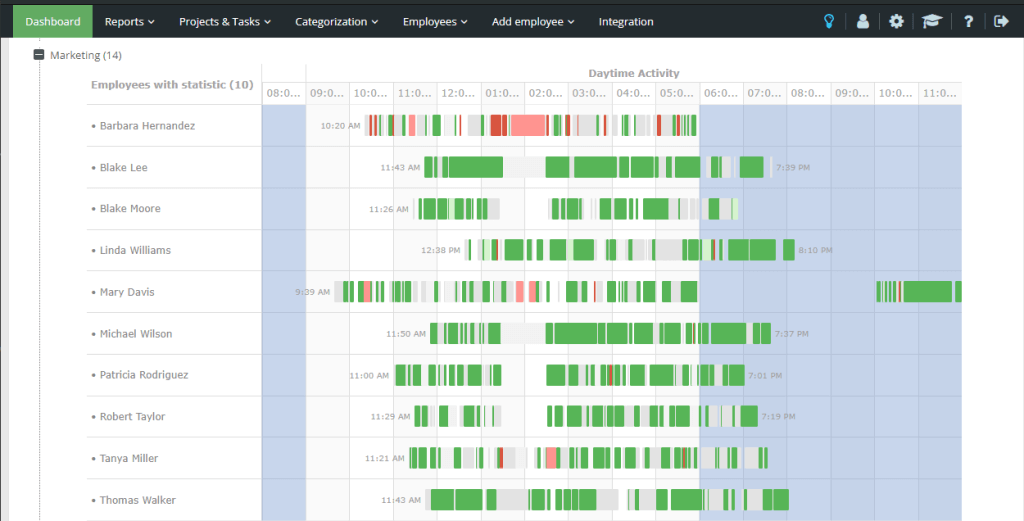Tracking time is no longer enough. As hybrid and remote work reshape team dynamics, the real challenge for managers is to see what's hidden: silent inefficiencies, energy leaks, and subtle drops in engagement that don't show up in timesheets. Many team leaders feel the pressure of results without having full clarity on where their teams are actually losing momentum.
The gap between activity and productivity is growing. Employees attend meetings, deliver outputs, and respond in chats, yet overall progress may stall. Traditional tools often miss the deeper patterns that explain why performance drops, even when schedules appear full.
Why team productivity drops without visible reasons
Performance is not just about hours worked. It's shaped by attention, context-switching, emotional bandwidth, and clarity of purpose. Managers often assume that visible engagement like message responsiveness or presence in meetings indicates productivity. But these signs are increasingly misleading.
Real productivity drains tend to operate under the surface: excessive time spent on low-impact tasks, delays caused by unclear ownership, and chronic context-switching that prevents deep work. Without automated insights, it's hard to detect these issues before they affect team output.
What AI sees that managers usually miss
AI-powered tools don't rely on check-ins or self-reporting. They observe behavioral patterns over time – such as how often tasks shift, when focus is fragmented, and where the biggest time sinks occur. This pattern-based visibility allows managers to respond before problems escalate.
Instead of flagging individuals, AI highlights systems: bottlenecks in handoffs, underutilized hours, or repetitive work cycles that drain energy. For example, a manager may see that a single weekly meeting causes a cascade of delays across four departments – a pattern that only becomes visible through long-term behavioral data.
Five early signs your team is silently losing productivity
Without automation, these indicators often go unnoticed. But they are reliable predictors of deeper inefficiencies:
- Repeated context switching across unrelated tools or projects within short timeframes
- Extended time-to-completion for tasks that previously took less effort
- Uneven distribution of workload that leads to burnout or disengagement
- Drop in proactive updates or self-initiated workstreams
- Frequent delays in feedback or decision-making cycles
If two or more of these patterns are happening simultaneously, it's highly likely your team is not operating at full capacity.
How AI-based tracking helps managers act with precision
AI doesn't just detect inefficiencies – it helps fix them. By analyzing aggregated behavior over time, intelligent systems recommend actionable steps: shift workloads, realign project ownership, or adjust feedback frequency. This reduces guesswork and builds a culture of continuous improvement.

Unlike surveillance tools that foster mistrust, AI-powered analytics focus on trends and patterns – not personal data. This distinction is crucial for ethical management. Leaders gain clarity without compromising employee autonomy or morale.
In a recent deployment, an HR director in a 50-person SaaS company used AI insights to identify overlapping roles across teams. As a result, the company redesigned their task routing process and saw a measurable 14% improvement in project delivery speed within three weeks.
What makes AI productivity analysis a strategic advantage
It's not about control. It's about visibility. With modern workloads becoming increasingly complex and distributed, managers need more than spreadsheets or intuition. They need data that explains not just what happened, but why.
Here's how AI-based analysis reshapes decision-making:
- It enables preemptive action instead of reactive fixes
- It tracks patterns that impact long-term performance, not just daily output
- It gives teams the chance to self-correct based on insights they trust
- It helps align goals with real-world execution speed
- It supports ethical transparency by focusing on system-level data, not individual surveillance
Managers who adopt this approach often report higher team engagement, fewer missed deadlines, and a stronger sense of shared responsibility.
How to get started with AI-driven insights without disrupting your team
Modern platforms don't require complex setup or workflow overhauls. Most integrate directly into the systems your teams already use, quietly collecting and analyzing data in the background. This allows for a smooth onboarding process and immediate value.
The sooner a team begins tracking its patterns, the faster it can identify areas of loss – and start recovering them. Delayed visibility often leads to costly corrections, while timely insights create space for sustainable improvement.
AI analytics doesn't replace management. It sharpens it.
To understand how this could work for your team, explore platforms that provide real-time dashboards, pattern recognition, and system-level insights. Use the data not to pressure people – but to empower smarter decisions.

